Articles
A Professional Keeping Shop:
The Nineteenth-Century Apothecary
Résumé
Prenant la boutique d'apothicaire de Niagara comme modèle, cette communication étudie l'évolution de la pharmacie au XIXe siècle: comment cette profession, qui consistait à distribuer au petit bonheur des médicaments faits, pour la plupart, d'ingrédients naturels, est devenue la science de substances extrêmement puissantes, presque toutes d'origine chimique et fabriquées en usine. L'étude relie les effets d'une meilleure instruction et l'influence d'organismes professionnels aux progrès remarquables de la science et de la technologie, qui sont à la base même de la pharmacie. L'auteur analyse également les façons dont une attitude généralisée de laisser faire dans l'exercice de la pharmacie a favorisé l'apparition de sectes botanico-médicales, la multiplication des spécialités pharmaceutiques et des médicaments brevetés, commer-cialisés avec fanfare, de même que l'entrée en jeu de petits métiers connexes sans rapport avec la santé. Tout en essayant dans la mesure du possible de faire le lien avec le XXe siècle, l'auteur met l'accent avant tout sur l'univers du travail au XIXe siècle, du point de vue de la pharmacie.
Résumé
Using the Niagara Apothecary as a focus, the paper explores how pharmacy evolved during the nineteenth century from a profession stressing extemporaneous dispensing of drugs largely of natural origin to one emphasizing scientific knowledge about highly potent agents, usually of chemical origin and usually manufactured in large manufacturing plants. It touches upon the influence of increasing standards of education and professional organizations, as much as the remarkable growth of the sciences and technology that provide the basis for pharmacy. It also analyzes the part that commonly held attitudes of laissez-faire had upon the development of botanico-medical sects, the growth of proprietary or patent medicines and their blatant advertising, and the involvement of non-health related sidelines in the practice of pharmacy. While trying where possible to make the bridge to the twentieth century, it will focus primarily upon the nineteenth-century world of work from the perspective of pharmacy.
1 At the present time in Canada, approximately twenty pharmacy restorations, re-creations, or museums are open to the public. While most of them tend to represent turn-of-the-century practice, the oldest one chronologically depicts the quarters of the apothecary Louis Hébert in the reconstruction of the early seventeenth-century Habitation in the Port Royal National Historic Park at Granville Ferry, Nova Scotia; the latest, re-creates a 1920s pharmacy in the Manitoba Museum of Man and Nature at Winnipeg. As interesting as each of these institutions across Canada is in its own right, it is no chauvinistic exaggeration to point to the Niagara Apothecary at Niagara-on-the-Lake, Ontario, as the most authentic restoration of its kind in Canada and perhaps in North America.
2 The apothecary is remarkable as the only surviving Confederation-period building in a town architecturally and historically noteworthy, not least of all as the first capital of Upper Canada. Also, at the time it closed (in 1964), it was one of the oldest pharmacies in Canada in continuous operation (from 1819-20 onward), and for nearly a century (from 1866) at the same location, with few changes inside or out from the original. Furthermore, at the time of the restoration (in 1971), many of the original containers returned to their former places in the shop. We use the Apothecary here as an appropriate frame upon which to hang our narrative and as a suitable source of pertinent illustrations.
3 When the "Niagara Apothecary at the Sign of the Golden Mortar across from Smith's Tavern" in Niagara-on-the-Lake was first established late in the second decade of the nineteenth-century, pharmacy was still in a raw state, as was also medicine and other professions, in Ontario, and in a pioneer or frontier state in much of the rest of British North America. Pharmaceutical practice was primitive compared with that of Continental Europe, and pharmacy as a true profession — if we consider all the criteria that apply, such as education, formal association, required competence, an accepted ethic, etc. — was perhaps really non-existent until the last quarter of the nineteenth century. This situation resulted not only because Canada was still relatively young but also because the main influences upon the development of pharmacy in Canada were British. In Britain itself, because of a peculiarly convoluted evolution and the predominantly laissez-faire philosophy that had prevailed, modern-day pharmacy as a permanent organized discipline with standards of education and practice really had its beginning only in 1841, that is more than two decades after the Niagara Apothecary was established. Even that development came only in reaction to the possibility of being controlled by medicine, which had organized somewhat earlier. Moreover, the first British Pharmacy Act, very rudimentary indeed, came only in 1852 with the first school having been founded by the Pharmaceutical Society of Great Britain in 1843 and the first journal in 1841.
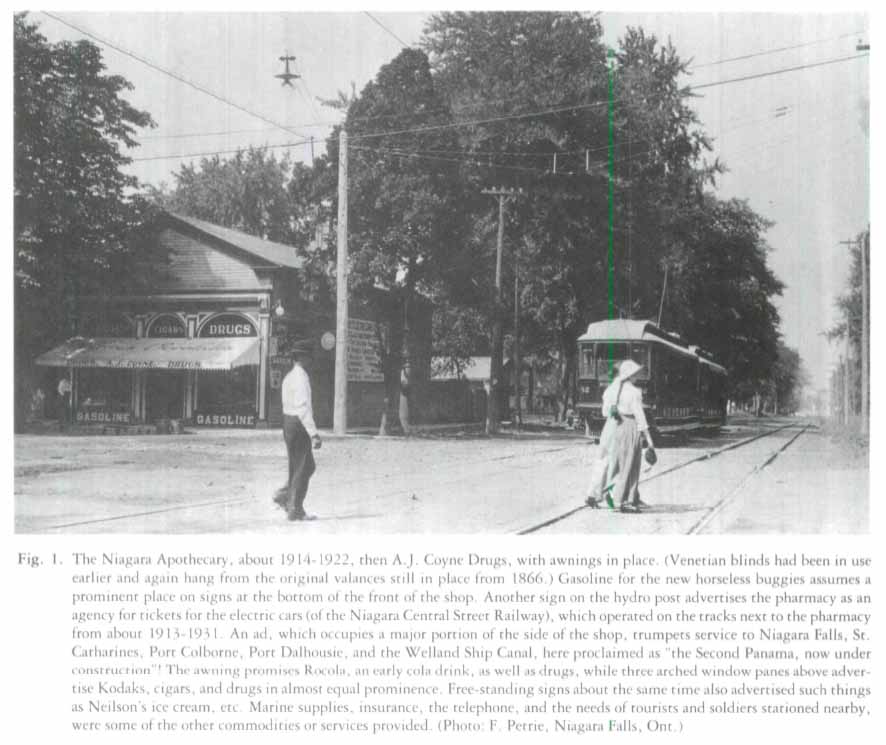 Display large image of Figure 1
Display large image of Figure 14 While this was late by Continental standards, where pharmacy had come into its own by the last quarter of the eighteenth century, it was late even by North American standards. The first permanent organization and school of pharmacy on this continent was established in Philadelphia in 1821, just after the Niagara Apothecary was founded, and the first permanent journal in the English language emerged from that same institution in 1825. Although the spirit of laissez-faire had reigned strong south of the border as well, the threat of medical domination, as it did in Britain, provided the necessary catalyst to foster cooperation and organization among American chemists and druggists.
5 The situation recurred in Ontario when on the very eve of Confederation, just after the Niagara Apothecary opened at its present site, attempts by organized medicine to control pharmacy led to the formation, among other groups, of the Toronto Chemists' and Druggists' Association, which evolved in a few months into the Canadian Pharmaceutical Society. Using the British Society and legislation as a model, they hoped to achieve national legislation. Unfortunately, early legislators after Con federation were occupied with other matters and to make matters worse D'Arcy McGee was assassinated at a c nni.il time in the progress of the Canadian pharmacy bill through the House. Eventually, the Canadian Pharmaceutical Society decided it would be better to press for provincial legislation; accordingly, it changed its name to the Ontario College of Pharmacy (now Pharmacists; OCP) in 1870 in anticipation of the first Ontario Pharmacy Act, which appeared early in 1871. The OCP, like its British model, was until the twentieth century a combination of the provincial licencing or regulatory body, the professional association, and the educational institution
6 While practitioners of pharmacy had sporadically come under various medical acts in Upper and Lower Canada before Confederation, these tended not to be enforced very consistently for medicine, let alone for pharmacy, particularly in less populated areas. Laissez-faire and the fluid state of the professions precluded the kind of rigid legislative and organizational controls that had long been instituted and accepted in Europe. It was possible for virtually anyone in Canada who wanted to practice to do so, by apprenticing with an existing practitioner or sometimes by obtaining the most rudimentary kind of self-education using standard textbooks or home-medicine books, such as Samuel Thomson's New Guide to Health, or Botanic Family Physician (1831), G.F. Payne's The Domestic Physician ( 1845), or Peter Smith's The Indian Doctor's Dispensatory (1812). While the preceptors may have been properly qualified apothecaries from Europe, they were more likely British chemists and druggists whose own training was sometimes less than adequate; moreover, the prevailing system in the New World often lacked whatever Old World historical tradition it was emulating. Physicians often practised pharmacy as well medicine, either by dispensing personally as well as diagnosing and prescribing or by owning a pharmacy, frequently with their medical consulting offices on the same premises.
7 This fluid situation also encouraged all kinds of irregular medical and pharmaceutical practices, particularly in the late eighteenth and early nineteenth centuries, when, often in reaction to the rather violent or drastic extremes of existing so-called "heroic" medicine (i.e., a heavy regimen of cathartics, emetics, narcotics, and bleeding), large numbers of unqualified practitioners, some rank charlatans, thrived. Many of these represented the new breed of medical empirics or botanies, like the Thomsonians, who had their beginning in the United States, promoting more innocuous botanical remedies, rather than the heavy doses of opium, mercury compounds, drastic cathartics and emetics, and bleeding then in vogue. They invaded Canada, especially rural Canada and especially southwestern Ontario, as Yankee entrepreneurs or more subtly, as United Empire Loyalists. Such irregular practitioners often also traded on the popularity of homegrown, one hundred per cent Canadian or American remedies, particularly some of those purported to have their origin with North American Indians. Such an association, aside from the mystique associated with it, made such drugs somehow more specific in their effectiveness against domestic maladies than "foreign" imported medications, particularly mineral ones.
 Display large image of Figure 2
Display large image of Figure 28 The heavy preponderance of drugs of vegetable origin and the ready availability of British and American patent or proprietary remedies, whose sale was usually exempt under existing legislation, made the task easier for those with less than adequate credentials, whether irregulars, or self-styled physicians or pharmacists. This laissez-faire attitude also allowed drugs to be sold in general stores, particularly the so-called "drug and bookstores," like that operated by William Lyon Mackenzie, rebel reformer and first mayor of Toronto. The lack of professional demarcation for pharmacy that this represents was also intensified by the necessity, either financial or circumstantial, for many early establishments, particularly in more rural areas, to carry a host of sidelines including paints, varnishes, and wallpaper; gunpowder and cement; seeds and dyestuffs. More or less frontier conditions often dictated such merchandising practices, as well as the need to earn a living at a time when this could not be guaranteed by more strictly pharmaceutical pursuits, particularly when the borderline between what constituted medical as opposed to pharmaceutical practice remained fuzzy; when the sale of drugs was not restricted to pharmacies; and when there was no limitation on the numbers of pharmacists or the number and location of pharmacies. Laissez-faire meant not only freedom of pursuit, but often also unbridled competition, with only minor concern for qualifications and public welfare.
9 That the Apothecary carried many of the sidelines noted above is evident in the advertising of the practice in the 1820s and 1830s. Other commodities and services continued to make their appearance throughout the nineteenth and into the early part of the twentieth century — veterinary remedies, gasoline, railway and boat tickets, postal insurance, marine supplies, and the telephone. Still other sidelines included selling ice cream and soft drinks (if not a full soda fountain), providing photographic supplies and services — also a British and American influence — and dispensing local weather information. Although there is no evidence in artifacts surviving in the Apothecary, many North American pharmacies late in the nineteenth and early in the twentieth centuries also had optical departments to test vision and supply spectacles.
10 A bewildering array of sidelines to help supplement the income of pharmacists, before the scope and level of his practice developed sufficiently to permit him a livelihood from prescriptions and related drug or health items, was part of the evolution of pharmacy even in Continental Europe. However, it occurred much earlier and its demise was hurried along by legislation in most cases as pharmacists emerged clearly as specialists distinct from physicians, grocers, etc. Thus the earliest specific legislation, although applicable initially to a relatively small geographic area, Sicily and Southern Italy, took elicit about the middle of the thirteenth century. In one way or another that eventually set the pattern for the rest of Europe. The British experience was certainly different and considerably later, as we have seen. Furthermore, the dispensing physician, long a fixture of the British scene, disappeared only with the extension of the British national health scheme in 1948. Another phenomenon that was principally Continental was the extent to which pharmacists, particularly German and French, contributed to chemistry and science during the late eighteenth and early nineteenth centuries. That was partly a reflection of the fact that as chemistry itself matured as a science in more or less recognizable modern form about this same time, it was often the pharmacy that served as the focal point for chemical activities and training, before chemical laboratories as such emerged. Thus in the pharmacy there existed the chemicals and equipment, the practical and theoretical knowledge, .is well .is the means of instruction through the apprenticeship-preceptor system. Of course, not all who received their training in this way remained pharmacists, many became chemists (in the modern, not British pharmaceutical sense). Moreover, while modern pharmacy evolved by building upon many sciences, chemistry was among the earliest and more important to be applied.
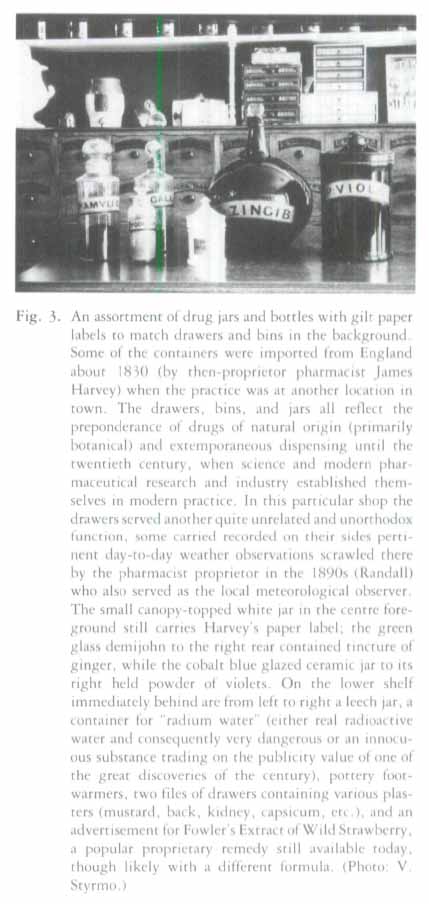 Display large image of Figure 3
Display large image of Figure 311 The science of chemistry provided the basis for a new type of production and ultimately for modern therapy While chemicals or minerals were used as drugs externally in ancient times, and promoted as internal remedies by Paracelsus and the chemists (those who viewed medicine from a predominantly chemical viewpoint) in the sixteenth and seventeenth centuries, they only found their way as internal medicaments into most pharmacopoeias by the end of the eighteenth century. The first significant new drugs to emerge such as morphine and quinine were extracted using the latest chemical techniques early in the nineteenth century, just about the time when the Niagara Apothecary was founded. The synthesis of drugs, as opposed to their isolation, followed. However, the predominant number or source of drugs remained botanical or vegetable through the nineteenth and into the twentieth century. Chemotherapy was a phenomenon of the twentieth century.1
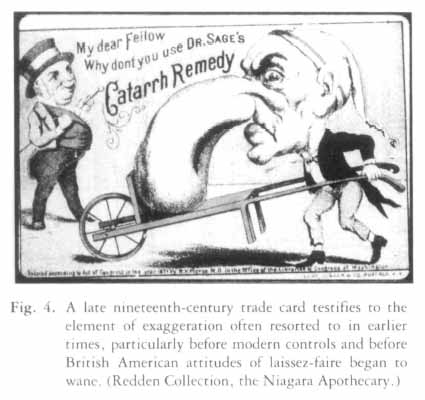 Display large image of Figure 4
Display large image of Figure 412 As drugs became more specific and more potent, more chemically rather than naturally derived, single entity rather than shotgun or polypharmaceutical formulations, and their quality could be better controlled, so the need developed for practitioners able to cope with the new science and technology that supported this development. At the same time, society (through government) gradually recognized pharmacy as an independent, socially necessary service.
13 In anticipation of or in reaction to these changes, one of the earliest tasks of the Ontario College of Pharmacy after 1871 was to develop standards of practice by controlling entry to the profession, first through apprenticeship, then through formal education. Before formal pharmaceutical education took definite shape, apprenticeship remained the principal means of instructing the new entrant to the field. A mainstay of the medieval guild system, under which future pharmacists spent from four to ten years as apprentices and journeymen before they became full-fledged members of the guild, the transition from emphasis upon apprenticeship to emphasis upon formal schooling reflected a transition from training for a trade to education for a profession. The question of whether such long periods of training were really necessary was answered differently depending upon whether one considered the minimal education or training required to perform the professional function or the practical maximum needed to provide optimal service and optimal standards in the profession. Pharmacy owners wanted to prevent overcrowding, guarantee high standards, provide adequate assistance in the shops, and gain some advantage during the later periods of apprenticeship for the trouble of initiating the neophyte — that is, benefit economically and professionally during the later years of an apprentice's indenture for the minimal return during the earlier years. Indentured apprentices were virtually the property of the preceptors, who regulated even their social lives and morals. Apprentices often worked long hours for meagre recompense; sometimes they lived on the premises, sometimes with the preceptor's family.
14 From the point of view of the apprentice, who in the process of learning also performed all or most of the menial tasks in the pharmacy, like cleaning, fetching, pounding crude drugs, preparing mixtures, making quantities of stock materials for producing powders, pills, cachets or suppositories, it must often have seemed that the main reason for such a long period of practical training was likely the desire to maintain cheap labour. In other words, if any apprentice were asked who was the pivotal figure in the nineteenth century pharmaceutical world of work, he would surely have nominated himself. At the same time, we must acknowledge that the apprentice certainly learned by doing and even by doing some menial tasks; thus dusting bottles not only served a utilitarian function but also helped drill or reinforce Latin terms, as well as the origin, use, properties, and doses of drugs.
15 Each of the manual procedures mentioned above carried with them corresponding pieces of equipment, all now obsolete. There were machines for cutting the pills and others for rounding and coating them; for making suppositories, cachets, etc.; for softening corks and for pushing corks into bottles; and for measuring powders and for folding powder papers.
16 On the Continent, when the guilds ceased to function, their place was usually taken by organizations of pharmacists, with more or less close relationships with government. These organizations served a function similar to the guilds, but also usually assumed some responsibility to the public in return for the public protection of the profession from unqualified entrants or competitors. The development of such an exchange of responsibility for protection may be viewed as an implicit recognition of the social necessity for a profession, a basic criterion. On the Continent, pharmacy in the modern sense was largely taking shape by the sixteenth century and was more or less stabilized by late in the eighteenth century. By that time, the process was barely beginning in North America and was delayed in many different ways by the predominant British influence — reinforced by American practice.
17 Specifically as far as education and the relative weight and placing of apprenticeship was concerned, the move to a better balance and order of practical training and schooling was often delayed in a system that perpetuated its weaknesses and protected its own. For, using the British mould, sometimes strengthened by the American, the same body served as professional organization, regulatory body, and educator. Association-run schools of pharmacy were long the norm in North America; indeed the first university-based schools, beginning with the University of Michigan in 1868, just after the Apothecary opened at its present location in Niagara-on-the-Lake, were at first so far off the norm that they were not welcomed or accepted into the early organizations of schools. One major and fundamental point of difference between them was that Michigan accepted students directly into its program, whereas apprenticeship was a prerequisite for admission to all association schools. In some cases the entire period of apprenticeship and an examination upon it needed to be completed before admission. In other cases apprenticeship was served in part concurrently with formal schooling, which could take place entirely during evenings or mornings to enable students to carry on in both spheres. As the functions of organization, regulation, and education gradually fell to separate bodies, so did pharmacy become a profession rather than a trade with a professional veneer.
18 Although a few of the early private schools survive in the United States, they do so as separate accredited degree-granting educational institutions, often with some affiliation with an established university. Apprenticeship, by whatever name it now goes, has shrunk to a mere vestige of what it once was and in some cases has become an integral part of the university program.
 Display large image of Figure 5
Display large image of Figure 519 But let us return to nineteenth-century Ontario. After irregular efforts that began soon after Confederation, the Ontario College of Pharmacy eventually established its own school in 1882. Registration of apprentices, with the equivalent of high-school entrance as prerequisite, first became compulsory in 1884; completion of the school program was required in 1889; first affiliation with the University of Toronto occurred in 1892, but a university degree was nor necessary until 1929, and the university assumed full educational responsibilities from the college only in 1953.
20 From those early times to the present the relative place and length of apprenticeship in relation to formal education have gradually become inverted. But at the end of the nineteenth century, an apprenticeship of four years and schooling of six months, all under the control of the licencing body, remained the requirements for entry to pharmacy in Ontario.2The nineteenth-century pharmacist spent a great part of his time rolling pills, folding powders, and making suppositories. He was taught the "art" of pharmacy, specific skills or techniques, many of which eventually became obsolete. This stress on manual skills gave way in the twentieth century to an emphasis on cognitive skills and thus on more formal education.3
21 Not only did the equipment of the pharmacy reflect this change, but so did also the very symbols that identified pharmacy. Where once those symbols reflected the everyday working tools of the pharmacist, like the mortar and pestle or balance or spatula, it has been estimated that in current practice the most commonly used tool or utensil is probably the stirring rod, not a very evocative symbol, and even that is in danger of atrophy. Indeed, the international symbol of pharmacy, now rather universally accepted, is the "Bowl of Hygeia," with origins in Greek mythology that reflect more the spiritual or social or clinical interaction of the pharmacist with the patient and physician than they do any manual prowess. Similarly the prescription sign, whose fanciful history is sometimes traced to Egyptian mythology, but which is more likely a product of the Middle Ages and Renaissance, represents the triad of medical care (the physician-patient-pharmacist relationship), rather than day-to-day physical skills. Put another way, we might say that pharmacy between the nineteenth and the twentieth centuries has become more a science than an art, with the underlying stress upon knowledge, understanding and communication.
 Display large image of Figure 6
Display large image of Figure 622 A more difficult transition to deal with is the degree or proportion of professional versus commercial or business activity in the practice of pharmacy. It has been said that every calling has its business side, including medicine and even the church, but in the case of pharmacy, and particularly that type of pharmacy most familiar to the public, community practice, the business side is very much more visible than it is in the case of many other professions. Granted there are very wide ranges of visibility from the small, personal, patient-oriented prescription practice or the hospital pharmacy to the large supermarker operation, that we are familiar with in North America. Aside from the range or degree, however, what carried the connotation of business, perhaps more than or as much as the nature of the premises, is the very real presence of a commodity, whether that be a prescription or home remedy purchased without prescription.
23 In that context, practices as reflected by the advertising of the Niagara Apothecary during its early stages as a "Cheap Cash Store," "cheaper than the cheapest," would have been illegal and unthinkable in pharmacies on the European continent at the beginning of the nineteenth century. That there is such a range still today also reflects at least the vestiges of our heritage in the British tradition, laissez-faire and all, as opposed to the Continental tradition of governmental or societal control, which may regulate everything from the number and locations of pharmacies and their premises to the nature of commodities that may be sold to the official standards that regulate them to the price that may be charged.
 Display large image of Figure 7
Display large image of Figure 7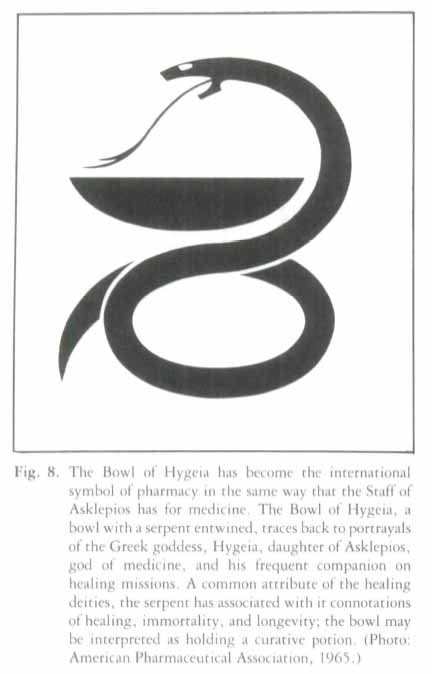 Display large image of Figure 8
Display large image of Figure 824 Present-day pharmacy places greater and greater emphasis upon effective communication between practitioner and patient, the mote obvious reason being because of the increasing need with the advent of powerful and potentially dangerous drugs for the patient to understand these medications in relation to his own medical history, In this stress upon greater pharmacist-patient interaction, we have seen a dramatic reversal or full circling of functions, both traditional and legal, particularly in North America. The sometimes stereotyped pharmacist of yesteryear who was often the first source of health-related advice — "doc" to many of his patients — was forced to withdraw to the passive role of provider of prescriptions and commodities in the 1940s to the 1960s. He was bound by the limitations of legislation that forbade him to change a physician's prescription in any way, because that was substitution, or to discuss that prescription (beyond its directions) or any other substantive health problems with the patient because that was "counter prescribing." So, effectively, the pharmacist's knowledge, often more detailed and specific than the physician's in some drug-related aspects, was channelled inwardly and product oriented. Much of that legislation in North America has now given way to other laws that permit, under certain circumstances, selection of prescription drugs by the pharmacist and communication of relevant health information to the patient. That the change has been slow reflects not only the resistance of physicians to give up a traditional function, but of pharmacists to re-accept one.
25 In this cursory paper we have explored the nineteenth-century world of work from the point of view of pharmacy and the Niagara Apothecary. As the profession changed from that time to the present, so did the world of work. Although there are times when we all question whether that world still exists, even in the general sense, as far as the profession of pharmacy is concerned, we must conclude that it does, but that the more obvious application of hands had given way in our definition and perception of work to the more sophisticated application of intellect.
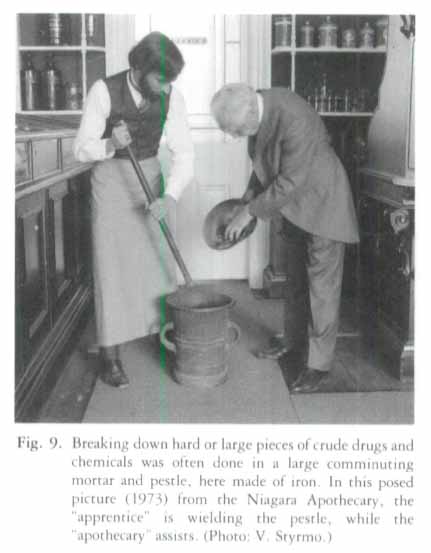 Display large image of Figure 9
Display large image of Figure 9APPENDIX Pharmacy Museums and Collections Open to the Public in Canada
Alberta
Calgary: Gledhill's Drug Store in Heritage Park. Originally built in 1908, the pharmacy meets the aim of the park to depict life on the Prairies before and after the development of the national railway in 1885 and before the First World War.
Edmonton: Daly's Drug Store in Fort Edmonton Park, in the pre-railway settlement area at the west end of Quesnell Bridge. Re-creates a pharmacy of about 1885.
British Columbia
Barkerville: J.P. Taylor Drug Store in Barkerville Historic Park. Re-creates a pharmacy in this gold-rush town of about 1869-1885.
Burnaby: Finlayson's Pharmacy and Way San Yuen Wat Kee and Company (Chinese herbalist's shop) in Heritage Park. Finlayson's re-creates a pharmacy of about 1890-1920 with artifacts from pharmacies of British Columbia's lower mainland. The herbalist's shop displays the entire contents of a company in operation from about 1903 until 1970 in Victoria.
Fort Steele: Pioneer Drug Hall in Fort Steele Historic Park. Reconstruction of a pharmacy first opened in Fort Steele in 1896.
Victoria: L.G. Cook Pharmacy in British Columbia Provincial Museum. Re-creates a shop of about 1900 in a turn-of-the-century street in the museum's modern history gallery.
Manitoba
Winnipeg: 1920 Drug Store in Manitoba Museum of Man and Nature, Urban Gallery.
Newfoundland
St. John's: Pharmacy Museum of Newfoundland Pharmaceutical Association. Artifacts relating to the history of the association and of pharmacy in Newfoundland.
Nova Scotia
Granville Ferry: Louis Hébert Quarters, The Habitation, Port Royal National Historic Park, Annapolis County. Re-creates the quarters of the first pharmacist to settle in Canada in this the first settlement in North America, founded in 1605.
Sherbrooke: Sherbrooke Drug Street in Sherbrooke Village. Re-creates a turn-of-the-century pharmacy.
Ontario
Lindsay: Apothecary shop in Victoria County Historical Museum. Re-creates a shop of the late nineteenth century.
Midland: Apothecary shop in Sainte-Marie among the Hurons, Huronia Historical Parks. Re-creation of the pharmacy for the period 1639-1649, in the only European settlement in Canada east of Quebec and Trois-Rivières; the apothecary is reputedly the earliest in inland Canada and the northern United States.
Minesing: 1890 Pharmacy in Simcoe County Museum. The recreation is part of a village street of 1890 in the main building of the museum.
Niagara-on-the-Lake: Authentic restoration of a pharmacy that opened on this site in 1866, but existed as a practice in the town going back to about 1820. Earliest artifacts from about 1830; original fixtures.
Toronto: Museum of the History of Medicine. Primarily a paediatric collection but does house a fine collection of seventeenth- and eighteenth-century pharmaceutical artifacts, as well as a few from ancient Egyptian and Greco-Roman times.
Quebec
Québec City: Musée de l'Hôtel-Dieu de Québec. A remarkable if disparate collection of artifacts from as early as 1639, when the hospital, the oldest in North America, was first established.
Saskatchewan
North Battleford: Drug store in Western Development Museum and Pioneer Village. Re-creates a shop of the early 1900s.
Saskatoon: Coad's Drug Store in Saskatchewan Western Development Museum. Located in the Boomtown Street area, Coad's evokes an early prairie pharmacy in Western Canada.
Adapted from a presentation to the Ontario Museum Association Heritage Conference 1983: "Industrious in Their Habits; Rediscovering the World of Work." Some of the background research on the Niagara Apothecary was supported by a grant, Health Research PR88, of the Government of Ontario.
For further details about content, hours, etc., see: Sami K. Hamarneh and Ernst W. Stieb, Pharmacy Museums and Historical Collections on Public View in the United States and Canada (Washington, D.C.: American Institute of the History of Pharmacy, in cooperation with the National Museum of American History, Smithsonian Institution, 1981), 107-119.